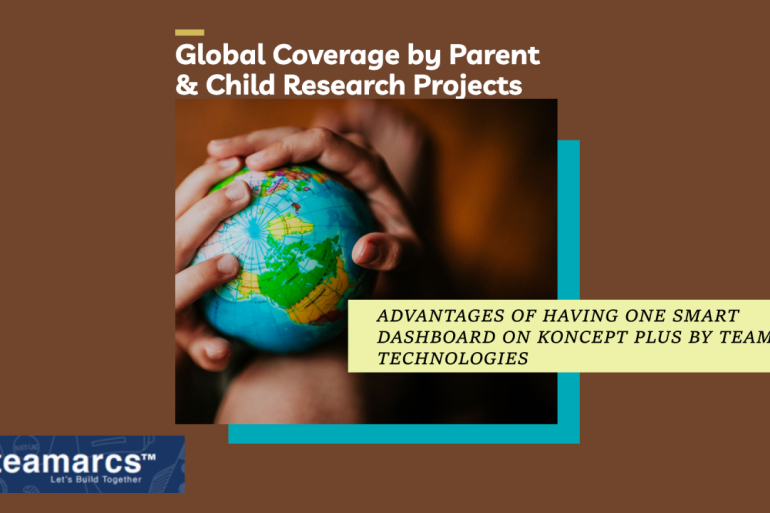The advantages of creating a parent & child research projects for Global Coverage

Creating a hierarchical structure of research projects with a parent project and multiple regional child projects can provide a systematic and organized approach to managing complex research initiatives. This structure allows for better coordination, segmentation of data, and targeted analysis based on regional variations. Let’s explore the features and advantages of implementing such a parent-child research project system.
Features:
1. Parent Project Dashboard:
–Overview: A comprehensive dashboard provides an overview of the entire research initiative.
–Project Hierarchy: Clearly displays the parent project and linked regional child projects.
–Progress Tracking: Monitors the progress of each child project in real-time.
2. Regional Child Projects:
–Individual Dashboards: Each regional child project has its dedicated dashboard.
–Data Segmentation: Segregates data based on regional parameters for focused analysis.
–Customization: Allows customization of survey instruments and data collection methods based on regional requirements.
3. Hierarchical Project Management:
–Project Creation: Easily create new regional child projects linked to the parent project.
–Permissions: Assign specific roles and permissions to researchers and collaborators based on their responsibilities within each project level.
4. Data Integration:
–Centralized Database: Integrates data from all regional child projects into a centralized database.
–Real-time Synchronization: Ensures that data updates from regional projects are reflected in the parent project in real-time.
–Data Mapping: Maps and standardizes regional data for uniform analysis.
5. Collaboration and Communication:
–Project-wide Communication: Facilitates communication across all levels of the project hierarchy.
–Document Sharing: Allows researchers to share documents, methodologies, and findings within the parent and child projects.
6. Reporting and Analytics:
–Aggregate Reporting: Generates aggregate reports that encompass data from all regional projects.
–Regional Reports: Provides specific reports for each regional child project.
–Cross-Regional Analysis: Enables researchers to compare and contrast findings across different regions.
7. Project Timeline and Milestones:
–Timeline Visualization: Displays the overall timeline of the entire research initiative.
–Milestone Tracking: Sets and tracks milestones for both the parent and regional child projects.
8. Budgeting and Resource Allocation:
–Resource Allocation: Allocates budgets and resources at both the parent and child project levels.
–Cost Tracking: Monitors expenditures for each regional project, ensuring financial accountability.
9. Survey and Data Collection Customization:
–Regional Survey Customization: Customizes surveys to address specific regional nuances.
–Consistent Methodology: Maintains a standardized approach to data collection across all projects when necessary.
10. Risk Management:
–Identifying Regional Risks: Allows for the identification and management of risks specific to each region.
–Adaptation Strategies: Facilitates the development of adaptive strategies based on regional project requirements.
Advantages:
1. Efficient Project Management:
– Hierarchical structure facilitates organized and efficient project management.
– Enables researchers to focus on specific regional aspects while maintaining a holistic view of the entire initiative.
2. Tailored Data Analysis:
– Regional child projects allow for tailored data analysis, considering unique regional characteristics.
– Researchers can identify trends, variations, and patterns specific to each region.
3. Flexibility and Adaptability:
– Easily adapts to changes in regional requirements without disrupting the overall research initiative.
– Flexibility in survey design and methodologies based on regional needs.
4. Comprehensive Reporting:
– Aggregate reports provide a comprehensive overview, while regional reports offer detailed insights.
– Supports both high-level decision-making and in-depth regional analysis.
5. Collaboration Across Regions:
– Fosters collaboration and knowledge-sharing among researchers working in different regions.
– Enhances cross-regional learning and coordination.
6. Strategic Resource Allocation:
– Allows strategic allocation of resources and budgets based on the unique demands of each region.
– Enhances cost-effectiveness and resource optimization.
7. Risk Mitigation:
– Identifies and addresses risks at both the parent and regional levels.
– Enables the implementation of targeted risk mitigation strategies.
Also read: The Future of Market Research: Embracing Change and Opportunity
In conclusion, implementing a parent-child research project structure offers a comprehensive and organized approach to managing complex research initiatives with regional variations. The features provided by such a system enhance project management, data analysis, collaboration, and adaptability, ultimately contributing to the success of the research initiative as a whole.